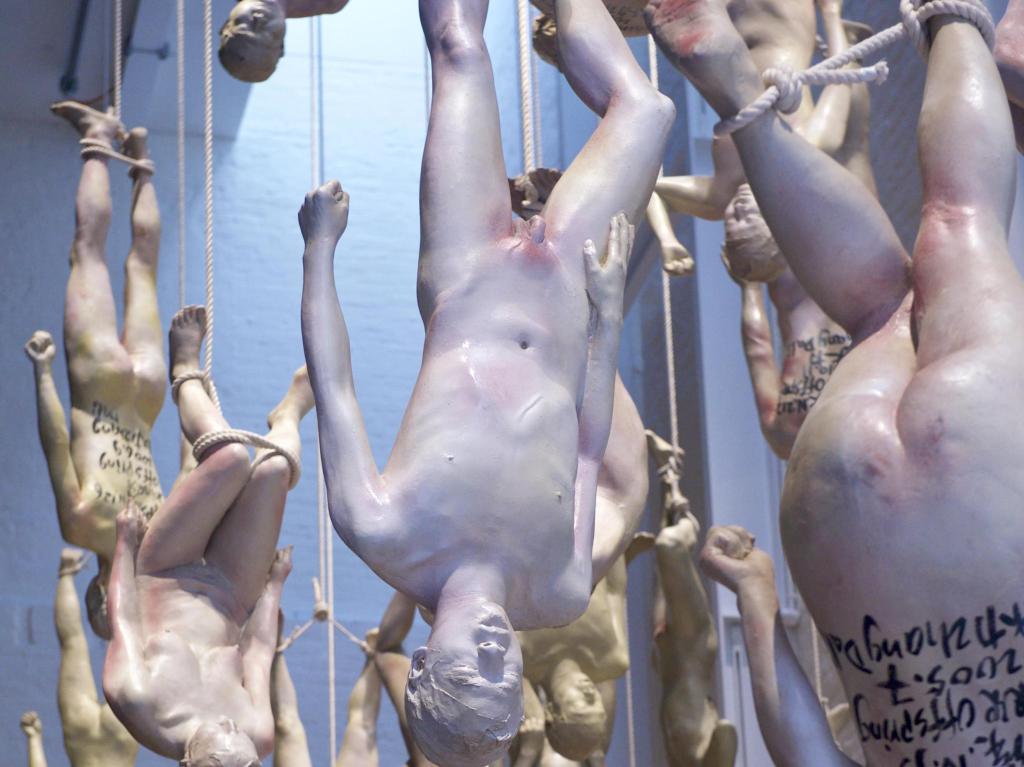Zhang Dali’s Chinese Offspring 2005, resin, life size, in the White Rabbit exhibition Vile Bodies.
As the vessel from which we all experience the world, with its myriad physical, sexual and emotional manifestations, ‘the body’ is a notion which has galvanised both art and popular culture for thousands of years.
The latest exhibition at White Rabbit Gallery, Vile Bodies, presents work by 22 contemporary Chinese artists exploring the human body’s intrinsic potential for evil and the monster dwelling just beneath the surface in all of us. Like a visual post mortem, it slices to the very core of our primal being; taking apart our collective consciences and laying bare our fears and imaginings, lusts and eccentricities, built-in bugs and defects for all to see.
When viewed through the lens of contemporary China, Vile Bodies becomes much more than a study of the body, but a highly politicised and fascinating window to a part of the world where rapid change is creating tension between the rising middle class and the state, speaking to issues of urbanisation, environmental destruction and social unrest.
In typical White Rabbit style, the ground floor gallery space creates a grandiose entrance to the exhibition with Zhang Dali’s Chinese Offspring, a mass hanging of rural-to-urban migrants. The figures are ‘numbered, branded and trussed like carcasses in a slaughterhouse’, shedding light on China’s archaic Hukou policy, which ties provision of social services to place, so that access to state-subsidised education, housing, healthcare, and pensions is not guaranteed if someone leaves their officially registered hometown. It’s a powerful tribute to these nameless citizens trapped in limbo, who flee rural towns under the false pretences of a better life and essentially become refugees in their own country.
Xia Xiaowan’s Man and Woman has that rare trifecta of subtle, seductive beauty, conceptual rigour and refined skill. The work slowly reveals itself as you traverse around its circumference, drawing you into its clutches, as if mimicking a slow acting poison. Inspired by medical CT scans, Xia Xiaowan’s deconstructs an image as if he were slicing up a body, and repaints it section by section on narrowly separated sheets of glass, the layers slowly shifting and distorting like delicate grey plumes of smoke.
Architect turned artist Cheng Dapeng’s Wonderful City is a commentary on the monsters of our own making and the moral destruction caused by the rapid urbanisation of cities. Created with 3D printing technology, he presents a city plan reminiscent of an architect’s impression, which on closer inspection is a sinister assemblage of anamorphic figures and mutated species, eerily rendered in a hyper-white. It’s exquisitely crafted and enchanting; you could spend hours running your eyes over the intricate curvatures and details.
On the top level you’ll find a 300kg robotic installation resembling a dragonfly floating through a silky, black void, which is equally impressive and mind boggling. Said installation is Wandering by artist team Luxury Logico (Chang Keng-Hau, Chang Geng-Hwa, Llunc Lin and Ken Chen), which reportedly took more than two years from concept to creation. While the exhibition text leaves its meaning open-ended, there is an obvious nod to science fiction and robotics, perhaps suggesting a future manifestation of Vile Bodies lies in the looming threat of sentience in artificially intelligent beings.
Vile Bodies is an expertly curated and well considered examination of the beauty and strangeness of the human body, exploring how it enslaves and empowers us, creating a mud-map of our vices and revealing the struggles we face personally and those we inflict upon others.
The exhibition presents work that some may find challenging or gruesome, but as artist Yu Lang said ‘I don’t care if the audience likes or hates it, so long as it makes them think’. This statement gets to the crux of what art should achieve; which is to broaden the mind, take us somewhere new and surprising, and challenge our perceptions. This is exactly what Curator David Williams and his team so skilfully realised with Vile Bodies. Audiences will leave with their minds, hearts (and bodies) feeling full.
Rating: five stars out of five
Vile Bodies
Curated by David Williams
White Rabbit Gallery
Vile Bodies runs until 5 February 2017





